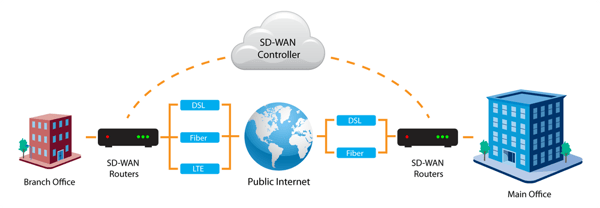Business networks are changing rapidly. Mobility, the cloud, and the Internet of Things (IoT) are giving organizations across the globe the opportunity to reevaluate efficiencies and security. Software Defined Wide Area Networks, or SD-WAN, is answering the call. This concept provides greater flexibility to manage the ever-increasing need for bandwidth as organizations look to securely connect remote offices, cloud applications, and cloud servers.

WAN vs. SD-WAN
Traditional Wide Area Networks (WAN) connect multiple business locations such as headquarters, branch offices, and data centers to one another. However, depending on your business, WAN architecture can be expensive and cumbersome to manage. On the other hand, SD-WAN simplifies the management and operation of a WAN by separating the networking hardware from its management and control mechanism. This can allow for lower costs and more flexibility within your network design.
 There are a variety of WAN technologies that provide varying levels of performance, security, and costs. Different, underlying technologies are used such as MPLS networks, frame relay circuits, VPN connections, ELAN, and many more.
There are a variety of WAN technologies that provide varying levels of performance, security, and costs. Different, underlying technologies are used such as MPLS networks, frame relay circuits, VPN connections, ELAN, and many more.
What they all have in common is that the “intelligence” is embedded in proprietary network hardware, however SD-WAN seeks to move more of the network control to the cloud, or to the end-user, by using a software-based approach.
SD-WAN Business Drivers
Businesses are demanding more flexible, cloud-based WAN technologies rather than installing WAN technology that often involves expensive, fixed circuits, and proprietary hardware. Many SD-WAN solutions can improve and secure Internet connectivity, making it more cost-effective than expensive legacy WAN technologies such as T-1 or MPLS. The cost per MB for public Internet is much less expensive than legacy technologies like MPLS.
In some cases, SD-WAN technology uses Internet broadband connections to replace these more expensive solutions. Virtual Private Networking (VPN) technology can be applied over less expensive broadband Internet connections, making them more secure; this is a more efficient setup all around.
SD-WAN Benefits: Cost, Reliability, and Security
The main goal of SD-WAN technology is to deliver cost-effective, business-class, secure, and simple cloud-enabled WAN connections. This can be used to deliver basic WAN connectivity, or it can be used for premium business services such as VPN, WAN optimization, and applications delivery control (ADC), or load balancing. Other benefits that are realized through an SD-WAN deployment are:
- Centralized control management
- Better application performance and bandwidth usage - this is particularly true with remote office locations
- Real-time support for core business and cloud applications
- More reliable and secure network at the same or less of a cost
- Fully meshed connectivity to ever-increasing applications in the cloud
As more companies begin to transition from a traditional WAN environment to SD-WAN; cost, reliability, and security will all improve; however, there are considerations organizations must realize before making the move.
If you would like to know how an SD-WAN solution could benefit your business, email info@systemsengineering.com, or call 888.624.6737. Customer, please reach out to your Account Manager.
 Dave Rizzo is an Account Executive at Systems Engineering. He has over two decades of IT experience. In his current role, Dave is responsible for maintaining customer relationships, preparing multi-year budgets, and develop IT roadmaps that align technology with his clients' business goals and plans.
Dave Rizzo is an Account Executive at Systems Engineering. He has over two decades of IT experience. In his current role, Dave is responsible for maintaining customer relationships, preparing multi-year budgets, and develop IT roadmaps that align technology with his clients' business goals and plans.





